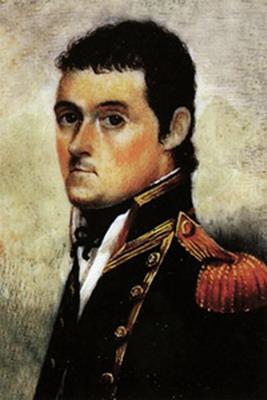|
|
|||
|
|
|
|
|
|
|
|||
Matthew Flinders1774 - 1814
|
|
|
|
|
Matthew Flinders was born on the 16th of March 1774 in Donington, Lincolnshire to Matthew Flinders Sr. (a surgeon) and Susannah Ward.
|
|
Mathew joined the Royal Navy as a midshipman aboard the Bellerophon (1) in October 1789 and then transferred as
Captain Bligh's (Mutiny on the Bounty fame) lieutenant aboard
the ship Providence in 1791. This voyage took him to New Guinea and Torres Strait of which he wrote:
|
|
|
Chronology
1774 - Born March 16th. 1789 - Joined the Royal Navy as a midshipman aboard the Bellerophon(1)He may have actually joined the Bellerophon in 1790. 1791 - Transferred to the Providence under Captain Bligh. 1794 - Took part in the battle known as 'The glorious first of June'. 1795 - First voyage to New South Wales. 1798 - Joined the schooner Francis on a voyage to the Furneaux Islands. 1798 - Given command of the Norfolk as a lieutenant. 1799 - Arrived in Moreton Bay once again sailing the Norfolk. 1800 - Rejoined the Reliance and sailed for England. 1801 - Published 'Observations on the Coasts of Van Diemen's Land, on Bass's Strait and its Islands, and on Part of the Coasts of New South Wales'. 1801 - Given command of the Investigator and promoted to commander. 1801 - Sailed for New Holland on July 18th 1801. 1801 - Journeyed to survey the southern coast and named Cape Leeuwin on December 6th. 1802 - Met Nicolas Baudin with the ships Geographe and Naturaliste in March. 1802 - Returned to Sydney on May 9th. 1802 - Sailed to survey the Queensland coast on July 22nd. Returned to Sydney via the west coast 1803 - Returned to Sydney on June 10th. 1803 - Sailed aboard the Porpoise that was then wrecked on a reef in August. 1803 - Landed in Mauritius on his way back to England as the ship he was on (Cumberland) was leaking badly. Taken captive by the French. 1804 - Despite being in captivity, Flinders managed to send a map of his explorations back to England in November. The map was titled 'AUSTRALIA' 1810 - After his release Flinders arrived in England on June 10th and was promoted to post captain. 1814 - Flinders' book is published in July 18th. 1814 - Died July 19th.
Links to more information:
The Life of Captain Matthew Flinders R.N.
|
|
|
Become a supporter of this website for just $5 a month
|


